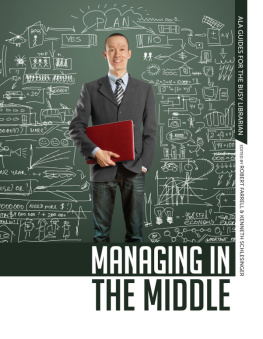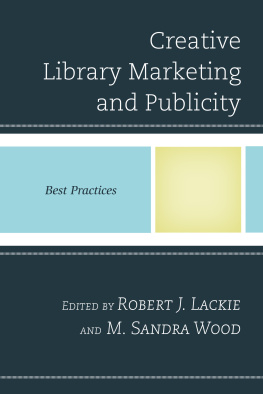Starting, MANAGING, and Promoting the SMALL LIBRARY
Starting, Managing, and Promoting the Small Library
Robert A. Berk
First published 1989 by M.E. Sharpe
Published 2015 by Routledge
2 Park Square, Milton Park, Abingdon, Oxon OX14 4RN
711 Third Avenue, New York, NY, 10017, USA
Routledge is an imprint of the Taylor & Francis Group, an informa business
Copyright 1989, Taylor & Francis. All rights reserved.
No part of this book may be reprinted or reproduced or utilised in any form or by any electronic, mechanical, or other means, now known or hereafter invented, including photocopying and recording, or in any information storage or retrieval system, without permission in writing from the publishers.
Notices
No responsibility is assumed by the publisher for any injury and/or damage to persons or property as a matter of products liability, negligence or otherwise, or from any use of operation of any methods, products, instructions or ideas contained in the material herein.
Practitioners and researchers must always rely on their own experience and knowledge in evaluating and using any information, methods, compounds, or experiments described herein. In using such information or methods they should be mindful of their own safety and the safety of others, including parties for whom they have a professional responsibility.
Product or corporate names may be trademarks or registered trademarks, and are used only for identification and explanation without intent to infringe.
Library of Congress Cataloging-in-Publication Data
Berk, Robert A.
Starting, managing, and promoting the small library / by Robert
Berk.
p. cm.
Includes bibliographical references.
ISBN 0-87332-576-1
1. Small librariesAdministration. 2. Small librariesCollection
development. I. Title.
Z678.B48 1989
025.1dc20
89-10704
CIP
ISBN 13: 9780873325769 (hbk)
For Laura, Holly, and Erika, along with all my former students in librarianship.
As author I am solely responsible for content, but it was only through the consistent support of my longtime friend and colleague, Dr. Donald D. Foos, that this work has finally been completed. Special thanks go to Sue Ealy for her multiple keyboarding efforts and to Roger Guard and Joe Profaizer for arriving in time.
This book is intended to serve as an introductory work on how to initiate and run a very small library. Its emphasis is on the one-person library, most commonly referred to as a special library, and as such is designed to aid the individual without library training who is suddenly faced with the need to plan and organize a library. A special library is one that is intended to meet the information needs of a business, or of a special group of users with clearly defined subject interests such as musicians, lawyers, physicians, and business people. Similar management problems are also associated with the very small public library, and issues addressed here should be of interest to those librarians as well. Further, it is the author's hope that the book will prove useful to librarians already involved in the operation of very small libraries by providing a means of review, and by identifying forgotten or new concepts and practices. Finally, library schools offering courses in special, public, and school librarianship should find this work useful.
The book is arranged to lead the user from the establishment of the library through the acquisition of materials, their organization, and the use of the library's collection in providing services to meet a variety of information needs. Other chapters deal with more effective management of the library through automation, evaluation of services, arrangement of physical facilities, effective public relations, and cooperation with other information agencies. The importance of conserving the librarian's time is emphasized throughout the work. With a limited staff, time is the key to productivity, and any savings in time enables the librarian to provide better and more effective means of meeting users' information needs.
Few references are included in the body of the work, but each chapter has a list of recommended readings. Older literature, when useful, has intentionally been included because its continuing value is often overlooked.
Starting, MANAGING, and Promoting the SMALL LIBRARY
One of the major functions of the librarian who is planning to bring library service to a group of potential users is to secure support for the concept of library service. Achieving this support for a proposed library, especially a very small one, may be difficult because the lack of library personnel will limit the extent to which reference service can be planned for the new facility. Support for a proposed library must first come from the top management of the business, organization, or institution in which the library is to function and whose goals the library will attempt to achieve. However, it is unlikely that everyone in the higher decision-making positions of the organization will see the need for the creation of a library. The attitude encountered may be, "We haven't had a library up until now and we have done very well without one." Even a one-person library that is capable of providing well-designed information services is an expensive undertaking if it is to be done right, and the would-be librarian may have a hard time convincing a reluctant manager that such a capital outlay is really in the best interests of the organization. Since creation of the library may well be dependent upon overcoming resistance, developing strategies aimed at convincing management of the need for library services is the responsibility of the librarian.
A number of arguments favor the establishment of library services for virtually any type of modern day endeavor. An unemployed librarian might start by trying to convince the top management of a local company that a library is needed if that company is to prosper, with the desired outcome being that the librarian would be hired to create that library and to begin meeting the information needs of the organization's employees. A useful strategy in this instance would be to document the number of firms or organizations with similar interests who have already established library services. The hardest fact to demonstrate, but undoubtedly the most relevant, is how the establishment of a library will aid in the attainment of organizational goals. In the business world it is necessary to demonstrate how library services influence organizational profits. Although profit is not important to all types of small libraries, in organizations where profits are important, everything, including the provision of library services, must be viewed relative to this goal. Directories such as the one by Darnay for special libraries and information centers may be useful for gaining a picture of current library development in a given area of specialization as well as for providing a wealth of additional information.
A potentially strong means for demonstrating the need for library service would be to show past situations in which information needs went unmet and how these unmet needs adversely affected the attainment of the organization's goals. Perhaps a contract was lost because of a bid that was too high based on lack of information or the use of inaccurate information. An examination of the company's internal documents and interviews with key personnel may identify such incidents. If adverse situations can be identified, it becomes the job of the librarian to suggest how a library might have overcome such critical incidents by providing information in an accurate and timely fashion.











